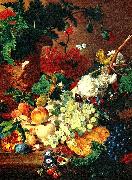
Oil On
Canvas, Real Flavor of Old Masters
|
Carl Larsson
|
|||
|
|
|||
| Swedish Realist Painter, 1853-1919 Swedish painter, illustrator and printmaker. He came from a poor family and studied (1866-76) at the Konstakademi in Stockholm, supporting himself throughout this period. From 1871 to 1878 he contributed illustrations to the comic journal Kaspar and the Ny illustrerad tidning. From 1875, for several decades, he was a prolific book illustrator, his most renowned work in this field being his drawings for Föltskärns beröttelser ('The Barber-surgeon's tales'; pubd 1883-4) by Zacharius Topelius, and the Rococo-inspired watercolours for the Samlade skaldeförsök ('Collected attempts at poetry'; pubd 1884) by the 18th-century Swedish author Anna Maria Lenngren. | |||
|
|
|||
|
|
stilleben new22/Carl Larsson-773987.jpg Painting ID:: 66270 Visit European Gallery |
olja på duk . troligen 1873 | |
Height Width |
INS/CM |
||
|
X |
|
||
|
|
|||
|
Jan van Huysum
|
|||
|
|
|||
| 1682-1749 Dutch Jan Van Huysum Galleries He was the brother of Jacob van Huysum, and the son of Justus van Huysum, who is said to have been expeditious in decorating doorways, screens and vases. A picture by Justus is preserved in the gallery of Brunswick, representing "Orpheus and the Beasts in a wooded landscape", and here we have some explanation of his son's fondness for landscapes of a conventional and Arcadian kind; for Jan van Huysum, though skilled as a painter of still life, believed himself to possess the genius of a landscape painter. Half his pictures in public galleries are landscapes, views of imaginary lakes and harbours with impossible ruins and classic edifices, and woods of tall and motionless trees-the whole very glossy and smooth, and entirely lifeless. The earliest dated work of this kind is that of 1717, in the Louvre, a grove with maidens culling flowers near a tomb, ruins of a portico, and a distant palace on the shores of a lake bounded by mountains. Some of the finest of van Huysum's fruit and flower pieces have been in English private collections: those of 1723 in the earl of Ellesmere's gallery, others of 1730-1732 in the collections of Hope and Ashburton. One of the best examples is now in the National Gallery, London (1736-1737). No public museum has finer and more numerous specimens than the Louvre, which boasts of four landscapes and six panels with still life; then come Berlin and Amsterdam with four fruit and flower pieces; then St Petersburg, Munich, Hanover, Dresden, the Hague, Brunswick, Vienna, Carlsruhe, Boston and Copenhagen. | |||
|
|
|||
|
|
stilleben new22/Jan van Huysum-255958.jpg Painting ID:: 67363 Visit European Gallery |
se | |
Height Width |
INS/CM |
||
|
X |
|
||
|
|
|||
|
alexej von jawlenskij
|
|||
|
|
|||
| Alexej Georgewitsch von Jawlensky (13 March 1864 ?C 15 March 1941) was a Russian expressionist painter active in Germany. He was a key member of the New Munich Artist's Association (Neue Kunstlervereinigung M??nchen), Der Blaue Reiter (The Blue Rider) group and later the Die Blaue Vier (The Blue Four). Alexej von Jawlensky was born in Torzhok, a town in Tver Governorate, Russia, as the fifth child of Georgi von Jawlensky and his wife Alexandra (n??e Medwedewa). At the age of ten he moved with his family to Moscow. After a few years of military training, he became interested in painting, visiting the Moscow World Exposition circa 1880. In 1896 he moved to Munich, where he studied in the private school of Anton Ažbe. In Munich he met Wassily Kandinsky and various other Russian artists, and he contributed to the formation of the Neue K??nstlervereinigung M??nchen. His work in this period was lush and richly coloured, but later moved towards abstraction and a simplified, formulaic style. Alexej von Jawlensky. Abstract Head, c. 1928Von Jawlensky died in Wiesbaden, Germany on 15 March 1941. He and his wife Helene are buried in the cemetery of St. Elizabeth's Church, Wiesbaden. | |||
|
|
|||
|
|
stilleben new23/alexej von jawlenskij-335435.jpg Painting ID:: 67568 Visit European Gallery |
1909 se | |
Height Width |
INS/CM |
||
|
X |
|
||
|
|
|||
|
georges braque
|
|||
|
|
|||
| Georges Braque (13 May 1882 --31 August 1963) was a major 20th century French painter and sculptor who, along with Pablo Picasso, developed the art movement known as Cubism. | |||
|
|
|||
| This artist (georges braque) is not available now. | |||
|
|
|||









